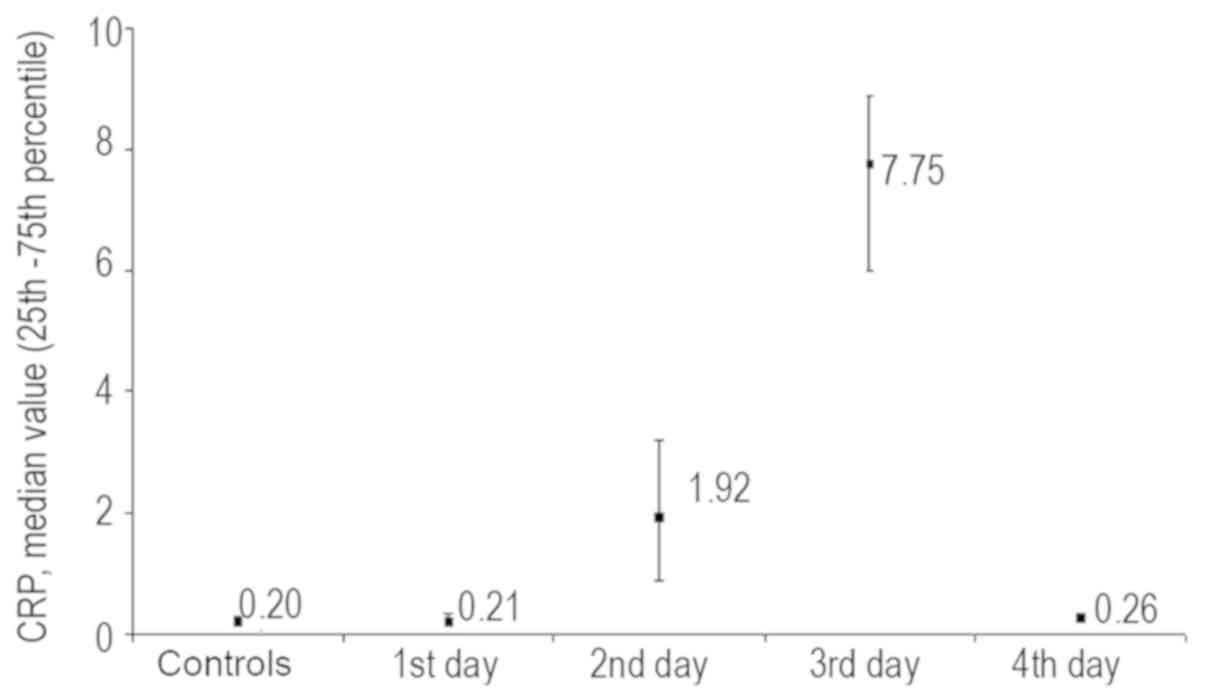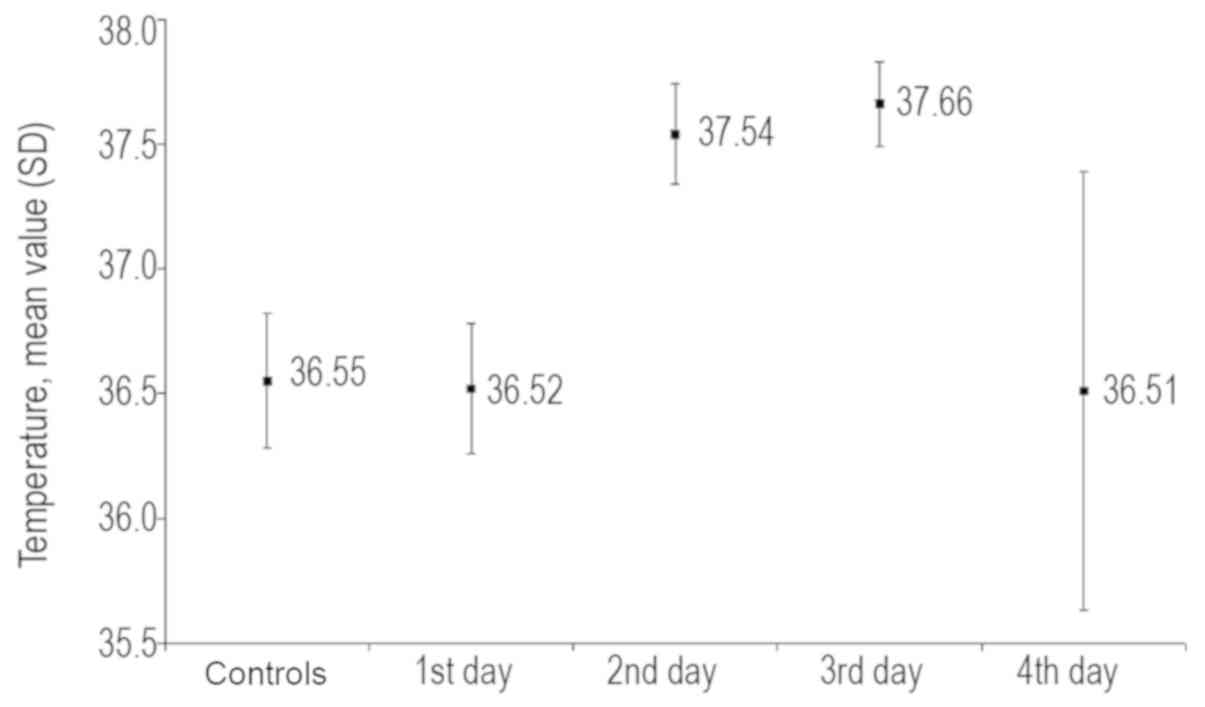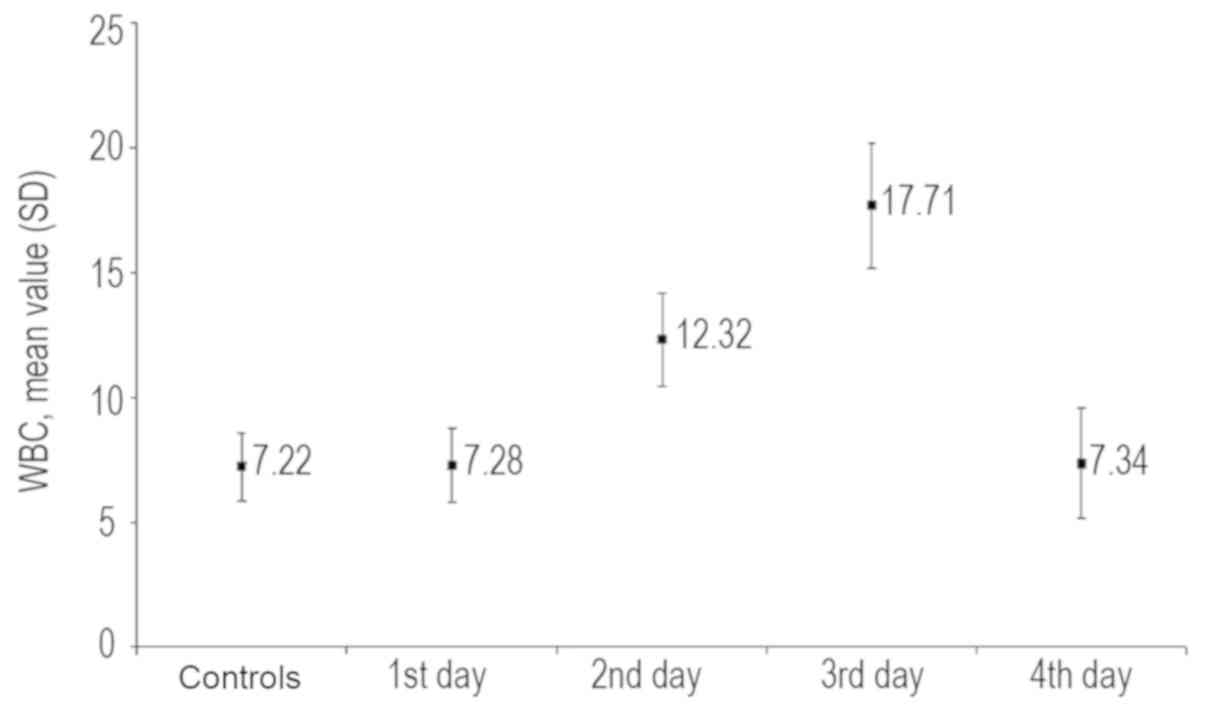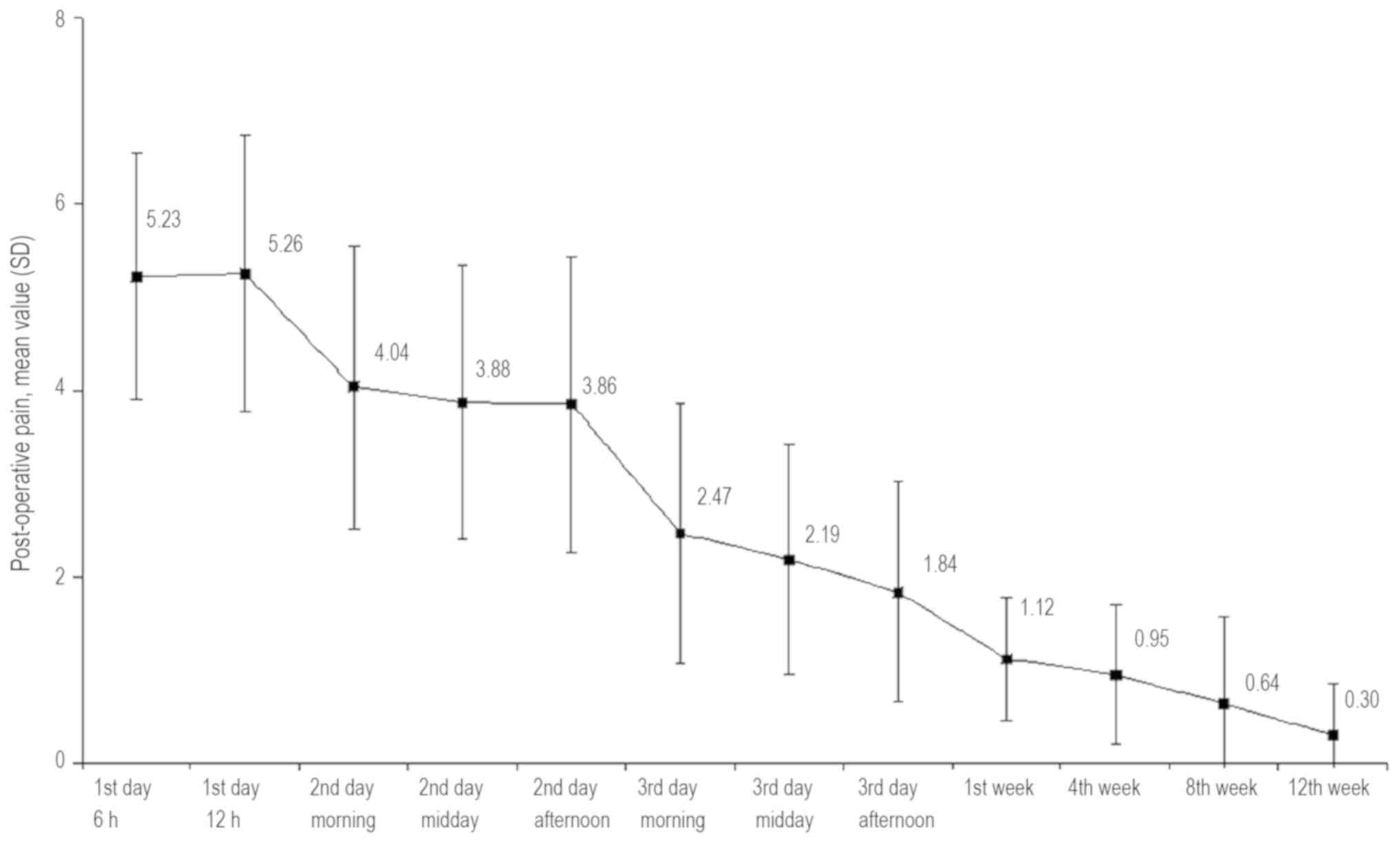|
1
|
Calaf J, Arqué M, Porta O and D'Angelo E:
The fibroid as clinical problem. Med Clin (Barc). 141 (Suppl
1):S1–S6. 2013.(In Spanish). PubMed/NCBI View Article : Google Scholar
|
|
2
|
O'Sullivan M and Overton C: Tailor
management to the patient with fibroids. Practitioner. 261:19–22.
2017.PubMed/NCBI
|
|
3
|
Donnez J and Dolmans MM: Uterine fibroid
management: From the present to the future. Hum Reprod Update.
22:665–686. 2016.PubMed/NCBI View Article : Google Scholar
|
|
4
|
Falcone T and Parker WH: Surgical
management of leiomyomas for fertility or uterine preservation.
Obstet Gynecol. 121:856–868. 2013.PubMed/NCBI View Article : Google Scholar
|
|
5
|
Stovall DW: Alternatives to hysterectomy:
Focus on global endometrial ablation, uterine fibroid embolization,
and magnetic resonance-guided focused ultrasound. Menopause.
18:437–444. 2011.PubMed/NCBI View Article : Google Scholar
|
|
6
|
Sabry M and Al-Hendy A: Medical treatment
of uterine leiomyoma. Reprod Sci. 19:339–353. 2012.PubMed/NCBI View Article : Google Scholar
|
|
7
|
Carbonell Esteve JL, Riverón AM, Cano M,
Ortiz AI, Valle A, Texidó CS and Tomasi G: Mifepristone 2.5 mg
versus 5 mg daily in the treatment of leiomyoma before surgery. Int
J Womens Health. 4:75–84. 2012.PubMed/NCBI View Article : Google Scholar
|
|
8
|
Wang S, Meng X and Dong Y: The evaluation
of uterine artery embolization as a nonsurgical treatment option
for adenomyosis. Int J Gynaecol Obstet. 133:202–205.
2016.PubMed/NCBI View Article : Google Scholar
|
|
9
|
Tomislav S, Josip M, Liana CS, Marko V,
Marko J, Ante R, Dzenis J, Leo G, Ivica S, Marijan T and Situm K:
Uterine artery embolization as nonsurgical treatment of uterine
myomas. ISRN Obstet Gynecol. 2011(489281)2011.PubMed/NCBI View Article : Google Scholar
|
|
10
|
Tropeano G, Amoroso S and Scambia G:
Non-surgical management of uterine fibroids. Hum Reprod Update.
14:259–274. 2008.PubMed/NCBI View Article : Google Scholar
|
|
11
|
Stampfl S, Stampfl U, Bellemann N, Sommer
CM, Thierjung H, Radeleff B, Lopez-Benitez R, Berger I, Kauffmann
GW and Richter GM: Biocompatibility and recanalization
characteristics of hydrogel microspheres with polyzene-F as polymer
coating. Cardiovasc Intervent Radiol. 31:799–806. 2008.PubMed/NCBI View Article : Google Scholar
|
|
12
|
Lohle PN, De Vries J, Klazen CA, Boekkooi
PF, Vervest HA, Smeets AJ, Lampmann LE and Kroencke TJ: Uterine
artery embolization for symptomatic adenomyosis with or without
uterine leiomyomas with the use of calibrated tris-acryl gelatin
microspheres: Midterm clinical and MR imaging follow-up. J Vasc
Interv Radiol. 18:835–841. 2007.PubMed/NCBI View Article : Google Scholar
|
|
13
|
Stampfl S, Bellemann N, Stampfl U, Sommer
CM, Thierjung H, Lopez-Benitez R, Radeleff B, Berger I and Richter
GM: Arterial distribution characteristics of Embozene particles and
comparison with other spherical embolic agents in the porcine acute
embolization model. J Vasc Interv Radiol. 20:1597–1607.
2009.PubMed/NCBI View Article : Google Scholar
|
|
14
|
Joffre F, Tubiana JM and Pelage JP: Groupe
FEMIC: FEMIC (Fibromes Embolisés aux MICrosphères calibrées):
Uterine fibroid embolization using tris-acryl microspheres. A
French multicenter study. Cardiovasc Intervent Radiol. 27:600–606.
2004.PubMed/NCBI View Article : Google Scholar
|
|
15
|
Gross KL and Morton CC: Genetics and the
development of fibroids. Clin Obstet Gynecol. 44:335–349.
2001.PubMed/NCBI View Article : Google Scholar
|
|
16
|
Meloni AM, Surti U, Contento AM, Davare J
and Sandberg AA: Uterine leiomyomas: Cytogenetic and histologic
profile. Obstet Gynecol. 80:209–217. 1992.PubMed/NCBI
|
|
17
|
Ligon AH and Morton CC: Genetics of
uterine leiomyomata. Genes Chromosomes Cancer. 28:235–245.
2000.PubMed/NCBI
|
|
18
|
Marsh EE, Lin Z, Yin P, Milad M,
Chakravarti D and Bulun SE: Differential expression of microRNA
species in human uterine leiomyoma versus normal myometrium. Fertil
Steril. 89:1771–1776. 2008.PubMed/NCBI View Article : Google Scholar
|
|
19
|
Raikhlin A, Baerlocher MO and Asch MR:
Uterine fibroid embolization: CME update for family physicians. Can
Fam Physician. 53:25025–25026. 2007.PubMed/NCBI
|
|
20
|
Marshburn PB, Matthews ML and Hurst BS:
Uterine artery embolization as a treatment option for uterine
myomas. Obstet Gynecol Clin North Am. 33:125–144. 2006.PubMed/NCBI View Article : Google Scholar
|
|
21
|
Szkodziak P, Szkodziak F, Trzeciak K and
Czuczwar P: Minimally invasive procedures in the management of
uterine fibroids. Prz Menopauzalny. 16:122–125. 2017.PubMed/NCBI View Article : Google Scholar
|
|
22
|
Vilos GA, Allaire C, Laberge PY and
Leyland N: SPECIAL CONTRIBUTORS: The management of uterine
leiomyomas. J Obstet Gynaecol Can. 37:157–178. 2015.PubMed/NCBI View Article : Google Scholar
|
|
23
|
Kubik-Huch RA, Weston M, Nougaret S,
Leonhardt H, Thomassin-Naggara I, Horta M, Cunha TM, Maciel C,
Rockall A and Forstner R: European society of urogenital radiology
(ESUR) guidelines: MR imaging of leiomyomas. Eur Radiol.
28:3125–3137. 2018.PubMed/NCBI View Article : Google Scholar
|
|
24
|
Cura M, Cura A and Bugnone A: Role of
magnetic resonance imaging in patient selection for uterine artery
embolization. Acta Radiol. 47:1105–1114. 2006.PubMed/NCBI View Article : Google Scholar
|
|
25
|
Early HM, McGahan JP, Scoutt LM, Revzin M,
Lamba R, Corwin M, Fananapazir G and Sekhon S: Pitfalls of
sonographic imaging of uterine leiomyoma. Ultrasound Q. 32:164–174.
2016.PubMed/NCBI View Article : Google Scholar
|
|
26
|
Tamai K, Koyama T, Umeoka S, Saga T, Fujii
S and Togashi K: Spectrum of MR features in adenomyosis. Best Pract
Res Clin Obstet Gynaecol. 20:583–602. 2006.PubMed/NCBI View Article : Google Scholar
|
|
27
|
Tsikouras P, Manav B, Koukouli Z,
Trypsiannis G, Galazios G, Souftas D and Souftas V: Ovarian reserve
after fibroid embolization in premenopausal women. Minim Invasive
Ther Allied Technol. 26:284–291. 2017.PubMed/NCBI View Article : Google Scholar
|
|
28
|
Kim MD, Kim S, Kim NK, Lee MH, Ahn EH, Kim
HJ, Cho JH and Cha SH: Long-term results of uterine artery
embolization for symptomatic adenomyosis. AJR Am J Roentgenol.
188:176–181. 2007.PubMed/NCBI View Article : Google Scholar
|
|
29
|
Levgur M: Therapeutic options for
adenomyosis: A review. Arch Gynecol Obstet. 276:1–15.
2007.PubMed/NCBI View Article : Google Scholar
|
|
30
|
Alvi FA, Glaser LM, Chaudhari A, Tsai S
and Milad MP: New paradigms in the conservative surgical and
interventional management of adenomyosis. Curr Opin Obstet Gynecol.
29:240–248. 2017.PubMed/NCBI View Article : Google Scholar
|
|
31
|
Stampfl S, Stampfl U, Bellemann N,
Radeleff B, Lopez-Benitez R, Sommer CM, Thierjung H, Berger I and
Richter GM: Immunohistochemical characterization of specific
inflammatory tissue reactions following embolization with four
different spherical agents in the minipig kidney model. J Vasc
Interv Radiol. 20:936–945. 2009.PubMed/NCBI View Article : Google Scholar
|
|
32
|
Kim HS, Czuczman GJ, Nicholson WK, Pham LD
and Richman JM: Pain levels within 24 hours after UFE: A comparison
of morphine and fentanyl patient-controlled analgesia. Cardiovasc
Intervent Radiol. 31:1100–1107. 2008.PubMed/NCBI View Article : Google Scholar
|
|
33
|
Lampmann LE, Lohle PN, Smeets A, Boekkooi
PF, Vervest H, van Oirschot CM and Bremer RC: Pain management
during uterine artery embolization for symptomatic uterine
fibroids. Cardiovasc Intervent Radiol. 30:809–811. 2007.PubMed/NCBI View Article : Google Scholar
|
|
34
|
Jensen LL, Handberg G, Helbo-Hansen HS,
Skaarup I, Lohse T, Munk T and Lund N: No morphine sparing effect
of ketamine added to morphine for patient-controlled intravenous
analgesia after uterine artery embolization. Acta Anaesthesiol
Scand. 52:479–486. 2008.PubMed/NCBI View Article : Google Scholar
|
|
35
|
Roth AR, Spies JB, Walsh SM, Wood BJ,
Gomez-Jorge J and Levy EB: Pain after uterine artery embolization
for leiomyomata: Can its severity be predicted and does severity
predict outcome? J Vasc Interv Radiol. 11:1047–1052.
2000.PubMed/NCBI View Article : Google Scholar
|
|
36
|
Valdes-Devesa V, Jimenez MDM, Sanz-Rosa D,
Espada Vaquero M, Alvarez Moreno E and Sainz de la Cuesta Abbad R:
Preoperative diagnosis of atypical pelvic leiomyoma and sarcoma:
The potential role of diffusion-weighted imaging. J Obstet
Gynaecol. 39:98–104. 2019.PubMed/NCBI View Article : Google Scholar
|
|
37
|
Margau R, Simons ME, Rajan DK, Hayeems EB,
Sniderman KW, Tan K, Beecroft JR and Kachura JR: Outcomes after
uterine artery embolization for pedunculated subserosal leiomyomas.
J Vasc Interv Radiol. 19:657–661. 2008.PubMed/NCBI View Article : Google Scholar
|
|
38
|
McLucas B, Chespak L and Kaminsky D: Myoma
necrosis following Gelfoam embolization of uterine myomata. Minim
Invasive Ther Allied Technol. 17:200–204. 2008.PubMed/NCBI View Article : Google Scholar
|
|
39
|
Choi HJ, Jeon GS, Kim MD, Lee JT and Yoon
JH: Is uterine artery embolization for patients with large myomas
safe and effective? A retrospective comparative study in 323
patients. J Vasc Interv Radiol. 24:772–778. 2013.PubMed/NCBI View Article : Google Scholar
|
|
40
|
de Bruijn AM, Lohle PN, Huirne JA, de
Vries J, Twisk M, QUESTA-Trial Group and Hehenkamp WJ:
Uterine artery embolization versus hysterectomy in the treatment of
symptomatic adenomyosis: Protocol for the randomized QUESTA trial.
JMIR Res Protoc. 7(e47)2018.PubMed/NCBI View Article : Google Scholar
|


















